More genre viewing
Yet another random selection of movies from recent viewing, leaning as usual towards genre titles – ranging from rather low-end efforts to higher-end productions.
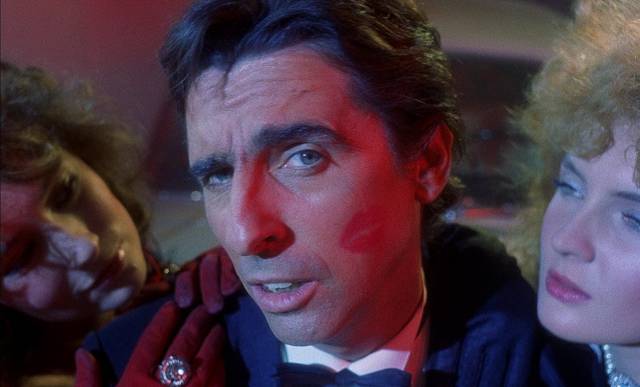
Monster Dog (Claudio Fragasso, 1985)
Among the former, yet another oddity from Claudio Fragasso (credited as Clyde Anderson), who for some reason has gained a strange hypnotic hold over me. My latest encounter may be my favourite so far, though it certainly can’t match the sheer weirdness of Troll 2. As in that movie, and Night Killer, Monster Dog (1985) is set in a strange idea of America, which here seems unanchored from any specific time and place. Set in a clifftop mansion with a view across a wooded landscape, it tells of a famous rock star who returns to the family home he left long ago, looking for inspiration. With his entourage tagging along, he plans to shoot a music video, but ends up encountering something scarier than music steeped in sex and violence.
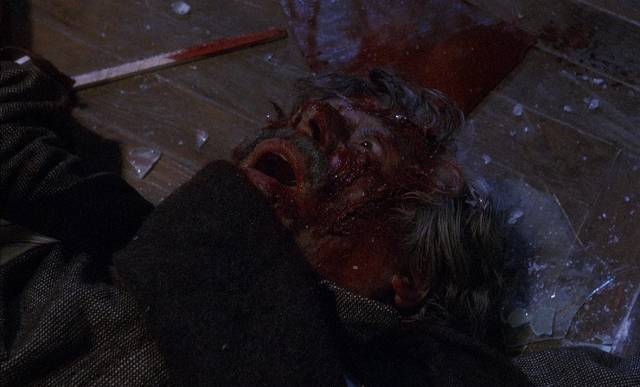
The area has been plagued by a series of deaths, the victims torn to pieces by what appears to be a pack of wild dogs. But the locals suspect there’s a werewolf on the loose – and they also suspect the curse is rooted in Vince Raven’s family … in fact, years ago they killed Vince’s father in an attempt to end the curse. As work on the video progresses, dead bodies turn up, members of the entourage are menaced by a pack of wild dogs, a bunch of redneck vigilantes arrive to threaten everyone, and Vince has increasingly disturbing dreams …
Shot in Spain, at no point does Monster Dog ever feel as if it’s taking place in the States. The rednecks, stripped of their cars and given horses, would fit comfortably into a spaghetti western. It all has an odd dreamlike ambience, culminating in the appearance of the title creature which is par for the pre-CGI period at this budget level.
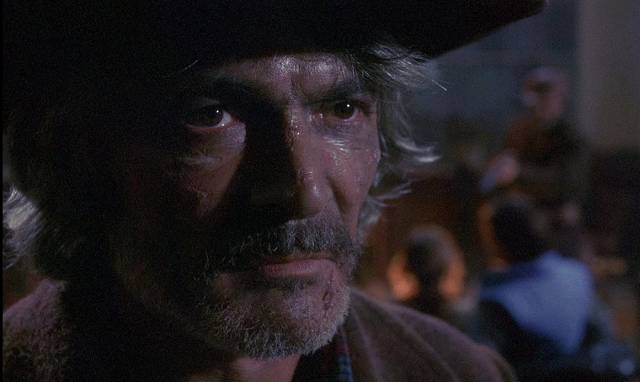
But what initially drew my interest was the presence of Alice Cooper as Vince Raven, playing it all surprisingly straight – though unfortunately stripped of his own voice, which was replaced by generic dubbing courtesy of the ubiquitous Ted Rusoff. Most of Cooper’s film and television work has been appearances as himself, with this apparently his only dramatic lead. Fragasso had Cooper knock out two songs for use in the movie, written and recorded a couple of weeks before shooting started. One, “Identity Crisises”, opens the film as a recently completed music video; the other, “See Me in the Mirror”, is the one being shot in the family home.
Not great art, certainly, and not as bizarre as Troll 2, but Monster Dog is the most coherent movie I’ve seen by Fragasso. Which makes it ironic that in a lengthy interview on the Kino Lorber Blu-ray Fragasso complains that the producer took his original cut, chopped twenty minutes out, and rearranged the rest, rendering incomprehensible what the director proudly claims was a great and serious film. But of course it should be remembered that Fragasso claims that Troll 2 is a serious piece of cinema. It’s this attitude which makes him seem increasingly endearing to me.
*
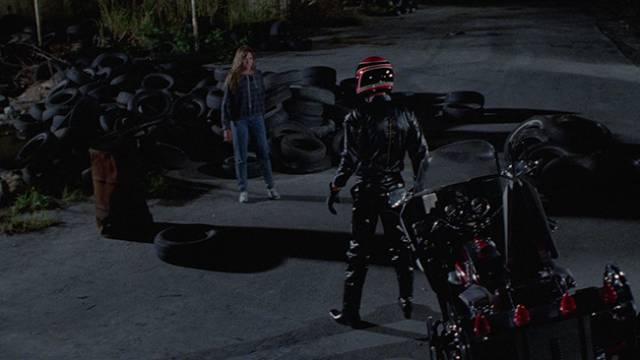
Nightmare Beach (Umberto Lenzi, 1988)
I definitely got more enjoyment out of Monster Dog than I did from Nightmare Beach (1988), a generic ’80s slasher whose strong suggestion of a supernatural element is abruptly stripped away at the end with a mundane “rational” explanation. I was given this KL Blu-ray by a friend who watched it and immediately decided he had no desire to keep it in his collection, so I was clearly forewarned. Set in Florida during Spring Break, it has a phantom biker killing various people with electricity, suggesting that he’s the resurrected gang leader Diablo who was executed by electric chair in the opening scene – for a murder, we eventually learn, that he didn’t commit.
There’s a mayor who’s trying to keep a lid on the increasing body count, a la Jaws, and a sheriff who behaves in very suspicious ways. The latter is played by John Saxon, who seemed to be the go-to actor for cop roles in horror movies at the time. Although it’s clear he framed Diablo (a rebel outsider) for the initial murder, it’s never clear that he knows the actual identity of the killer and the movie builds him up as the biggest red herring.
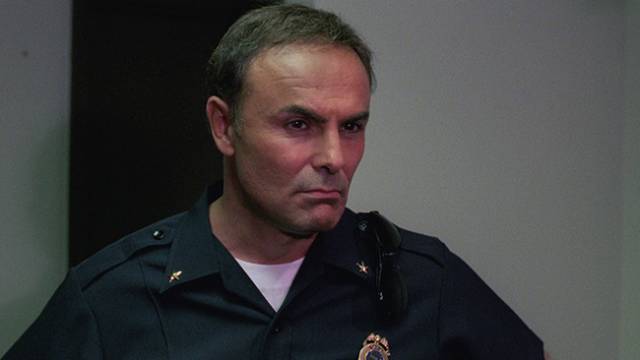
Although slickly produced and made on a fairly large scale, Nightmare Beach is bland and uninvolving. I actually didn’t know anything about it before watching – I didn’t even read the back of the disk case – so it was only after the fact that I learned it was co-written and co-directed by none other than Umberto Lenzi (under the name Harry Kirkpatrick), past his prime here. I certainly wouldn’t have guessed it was his work, though I assume he was largely responsible because his co-writer and -director James Justice has no other credits to speak of.
The disk has an excellent image, mastered in 4K, and a commentary from Samm Deighan – I just sampled this long enough to hear her enthuse about how great the film is. There’s also an interview with the great Claudio Simonetti about the score, which is unfortunately as unmemorable as the movie itself.
*
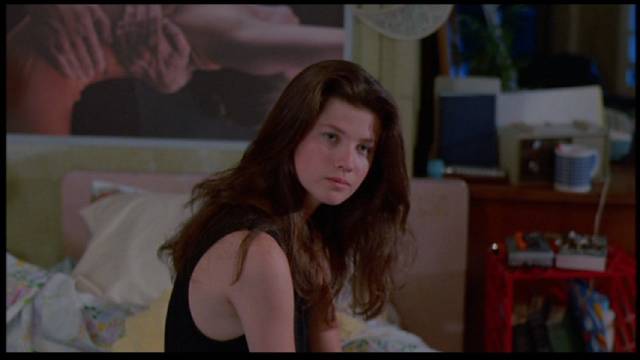
The Initiation (Larry Stewart, 1984)
Also very generic is Larry Stewart’s The Initiation (1984). After a giallo-like prologue featuring a young girl, a collection of dolls with their heads torn off, a primal scene in the parents’ bedroom, a knife, an intruder, and a man apparently burned to death, we meet the troubled Fairchild family – Mom, Dad and daughter Kelly. Giving the movie some superficial credibility, the parents are played by Vera Miles and Clu Gulager. Kelly was the first starring role for Daphne Zuniga, which she immediately followed up with the more respectable The Sure Thing (Rob Reiner, 1985). Buried secrets cause tensions in the family, and Kelly is glad to get away to college, where she’s undergoing hazing to get into a sorority.
The final challenge is to get into her dad’s big shopping mall one night with several other pledges to steal the security guard’s uniform. Naturally, the bitchy girl in charge has plans to torment Kelly and the others by sneaking into the deserted mall to terrify them. Meanwhile, a man severely deformed by burn scars has escaped from a mental hospital, leaving a few dead bodies along the way back to town. Everything converges at the mall, where fun and games quickly devolve into bloody slaughter.
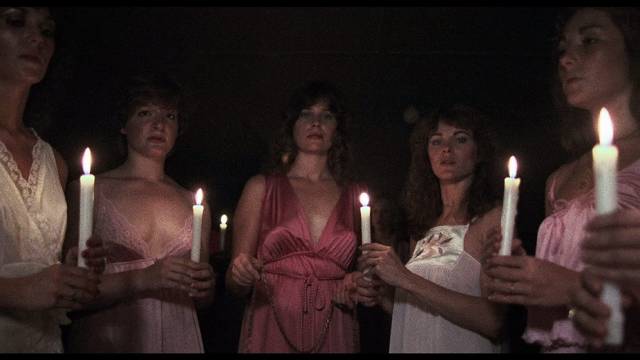
One big reveal is pretty obvious quite early on – the identity of the scarred man and most of what happened in the prologue. But right at the end, a surprise plot twist comes out of nowhere – writer Charles Pratt Jr, in an interview on the disk, references The Sixth Sense and the idea that the reveal makes you go back and rethink everything you’ve just seen; I admit I didn’t put a lot of effort into it, but I can’t say it made much sense to me.
Zuniga does a good job, but Stewart’s direction is not much more than efficient and functional, not making as much out of the deserted shopping mall as a more imaginative filmmaker might have. (The movie actually started shooting with Englishman Peter Crane directing, but apparently his arty style was wasting too much time and the producers quickly fired him and brought in TV director Stewart, whose only feature credit this was.)
Arrow’s 2K restoration has a fairly grainy image, reflecting the tight budget and brief shooting schedule. There’s a commentary, and interviews with the writer and a couple of the supporting actors.
*
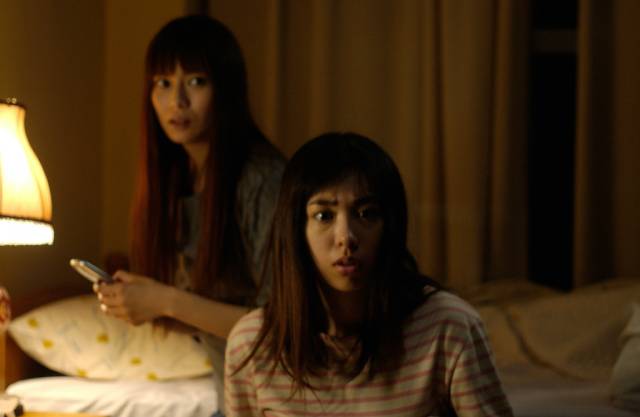
One Missed Call Trilogy (Takashi Miike et al., 2003-2006)
I’m not sure what made me buy Arrow’s two-disk, three-movie One Missed Call set. Chalk it up to an uncontrollable completist compulsion. When I saw Takashi Miike’s One Missed Call (2003) fifteen-odd years ago, I was very disappointed. This was made just after one of his finest films, Gozu (also 2003), yet it seemed so conventional and unengaged that it was hard to see why he had bothered. Although it was only five years since Hideo Nakata’s Ringu (1998), the trope of the Japanese vengeful ghost and the serial curse had become increasingly exhausted; it desperately needed an injection of originality, which one might have expected Miike to provide, but there are no surprises in One Missed Call. The film just goes through familiar motions on its way to an inconclusive end. (Sono Sion played with the genre conventions much more inventively four years later in Exte: Hair Extensions, which stretches the creepy long hair trope to absurdly surreal extremes.)

Watching One Missed Call again all these years later, I’m still unable to see anything fresh added to the familiar storyline. People start receiving voicemails from themselves three days in the future, in which they hear their own deaths. The most successful set-piece is a sequence in which one doomed girl is persuaded to appear on live TV at her appointed time so an exorcist can cancel the curse on air. It doesn’t go well; the exorcist is psychically attacked and the girl is brutally twisted by the ghost like a flesh pretzel.
One Missed Call 2 (2005), directed by Renpei Tsukamoto, tries to stretch the idea of cursed phone calls by expanding the curse beyond Japan to Taiwan, where the ghost’s grandfather lives. One Missed Call: Final (2006), directed by Manabu Aso, manages to wring a more interesting twist from the formula. A group of Japanese students on a school trip to South Korea start to receive the familiar messages, but this time they’re given the option of saving themselves by forwarding the curse to someone else in their phone’s list of contacts. This definitely ramps up the tension as they have to choose between sacrificing themselves or dooming a friend. The thin veneer of civilized behaviour is quickly peeled away by escalating fear and paranoia.

One of the series’ odd weaknesses is that pretty much everyone knows about the curse almost from the beginning … the kids in the first movie have heard about it; the news media are onto it. The sense of isolation and desperation which amplifies the fear in Ringu is absent here. Perhaps this is the series’ main innovation: everyone lives in a world where these curses, typically the work of angry, abused children, are an established part of everyday life. But that doesn’t save the trilogy from seeming over-familiar and cliched.
The hi-def transfers are decent if not spectacular, and Arrow have packed the set with making-of documentaries, behind-the-scenes featurettes, a couple of short films, and a commentary on the first film by Miike biographer Tom Mes.
*
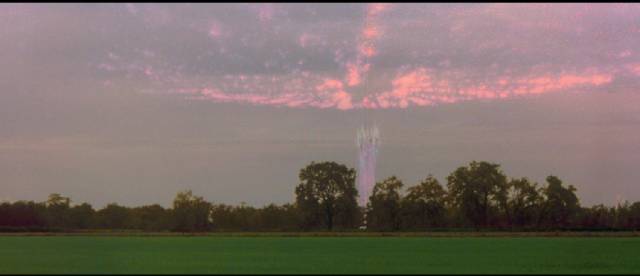
The Puppet Masters (Stuart Orme, 1994)
The mid-20th Century was an incubator for paranoia. After horrific wars, the Depression, the Holocaust, and the horrors of totalitarianism, the very idea of security seemed untenable. Pop culture naturally found ways to express these deeply felt fears – film noir, Red Scare spy movies, and a string of science fiction narratives in which the very essence of individual identity was under threat. John W. Campbell’s 1938 novella Who Goes There? was a key text, somewhat simplified in the Howard Hawks/Christian Nyby movie The Thing from Another World (1951) and eventually restored to its full paranoid potential in John Carpenter’s 1982 masterpiece The Thing.
Alien entities take control of people’s minds in Joseph Millard’s 1941 novel The Gods Hate Kansas, adapted by Amicus Films in 1967 as They Came from Beyond Space (dir. Freddie Francis). The most effective and influential version of this type of narrative was Jack Finney’s The Body Snatchers, whose impact was enduringly cemented by Don Siegel’s 1956 movie version, Invasion of the Body Snatchers, which more than the novel itself has inspired multiple remakes.
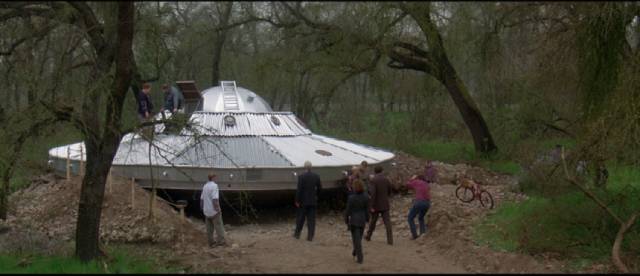
Between Millard’s and Finney’s novels, the most revered science fiction author of the time wrote his own variation. In Robert A. Heinlein’s The Puppet Masters, published in abridged form in 1951 (the full text would only appear in 1990, two years after Heinlein’s death), alien parasites from Saturn’s moon Titan land in Iowa and take people over by attaching themselves to their victims’ spines, controlling them like, well, puppets.
Heinlein’s story is more of a hardboiled action narrative, focused on agents of a secret intelligence organization fighting to prevent the spread of the slugs. Although well-told, The Puppet Masters lacks the psychological horror which gives Finney’s story its depth. Perhaps this (and the stature of Siegel’s film) explains why it took more than forty years for an official adaptation to arrive (with little fanfare) on screen – though there were quite a few unofficial adaptations, like Bruno VeSota’s The Brain Eaters (1958), the 1964 Outer Limits episode “The Invisibles”, and the first season Star Trek episode “Operation Annihilate!”.
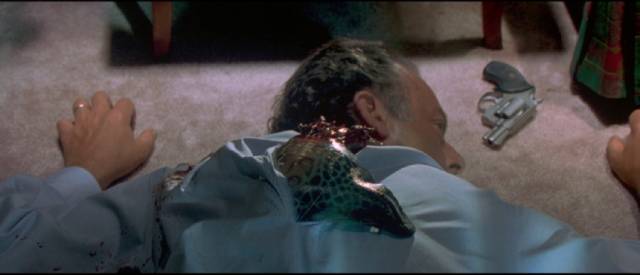
The biggest problem with Stuart Orme’s The Puppet Masters (1994) is that by the time it was released, it felt really, really derivative. It’s not that it’s a bad film – it’s competently crafted, with a decent cast – just lacking sufficient invention to make it seem necessary. Donald Sutherland plays it straight as the head of the agency investigating the invasion; Eric Thal plays his top agent, who also happens to be his son (their relationship is naturally testy), while Julie Warner is appealing as the exobiologist who’s recruited to the team. At various times in the story, all the major characters find themselves possessed by the slugs, which does add to the air of menace.
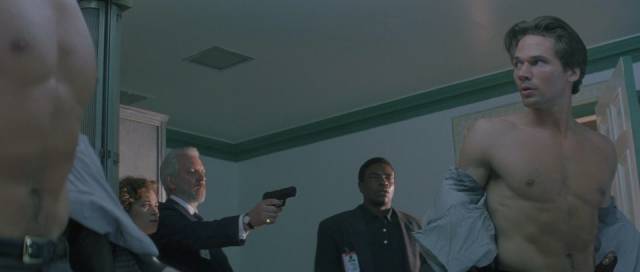
Perhaps the best part of the film are the slugs themselves, practical effects overseen by Greg Cannom which are the best alien critters since Alien’s face-huggers. With their mucousy internal organs and nasty tails equipped with a long needle to puncture their victims’ spines, they’re a convincing biological menace. But beyond them, the film leaves a rather bland, generic impression … particularly in comparison with Paul Verhoeven’s spectacular adaptation of Heinlein’s Starship Troopers just three years later.
Kino Lorber pulled out all the stops in bringing The Puppet Masters to Blu-ray, with a director’s commentary, a half-hour documentary on Heinlein, and interviews with three actors and the animatronics designer.
*
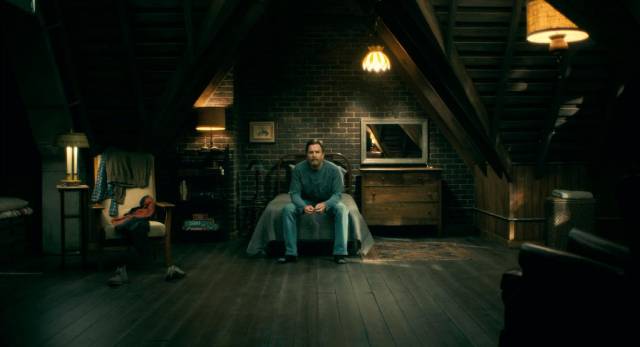
Doctor Sleep (Mike Flanagan, 2019)
I’ve liked most of what I’ve seen from Mike Flanagan, although his ability to create an effective sense of dread which gives force to well-placed moments of visceral shock is occasionally tempered by a whiff of New Agey uplift. However, I didn’t go to see Doctor Sleep (2019) when it was released in theatres because, apart from very mixed reviews, the film’s promotion seemed to lean really hard on its connection to Stanley Kubrick’s The Shining – trailers seemed to consist of specific visual and narrative references to Kubrick’s movie (which I have remained highly ambivalent about for forty years) rather than the sequel itself.
A couple of friends, however, told me they liked it and when it was released on disk a director’s cut was included, which at least offered the possibility that some of the narrative issues mentioned in reviews may have been addressed. As it turns out, the longer version does feel well-proportioned, with a pleasing slow-burn pace and engaging characters. I really liked Stephen King’s novel, and writer-director Flanagan does capture the mood of it quite well.
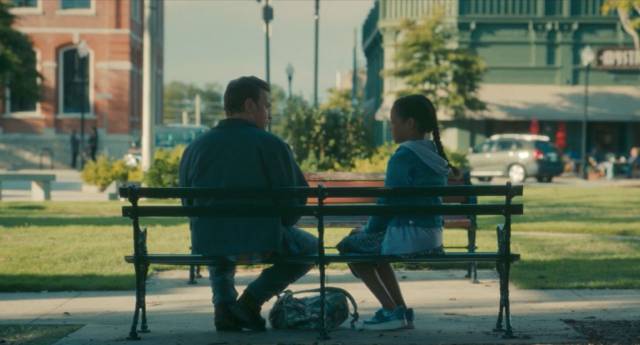
Most interestingly, he manages to sew together both King’s Shining and Kubrick’s version, almost seamlessly blending the original with Kubrick’s significant changes. But that said, Flanagan’s success in this risks undermining his own accomplishment because in the final stretch, once the characters converge on the abandoned Overlook Hotel, he chooses to cede the visual and narrative details to a recreation of Kubrick’s very distinctive approach to the material. These reminders of the 1979 film distract from what has been best and strongest in the new story up to that point.
Up to then, Flanagan gives us three characters who engage us fully – the adult Dan Torrance (Ewan McGregor), still tormented by his childhood experiences, following his father into chronic alcoholism both to suppress those memories and to dull the “Shine”; Abra Stone (Kyliegh Curran), an adolescent girl with a Shine even stronger than the young Danny’s; and Rose the Hat (Rebecca Ferguson), matriarch of a clan of almost-immortals who have roamed the world for centuries, feeding off those who have the Shine.
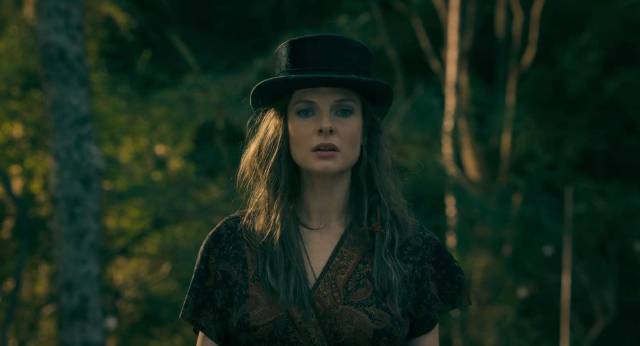
Rose and her trackers have sensed the existence of Abra and set out to find her and replenish themselves. Abra in turn has sensed both them and Dan, and she enlists his reluctant help in finding these monsters after she “witnesses” their horrific killing of a young boy. The cat-and-mouse contest eventually leads them all to the Overlook, once again buried under winter snow, and Dan reawakens the power residing there to use against Rose.
Performances are excellent and there are moments of genuinely disturbing horror. Flanagan’s sensitivity to detail is apparent in the flashback scenes to Danny’s post-Overlook childhood, with Roger Dale Floyd a dead-ringer for Danny Lloyd in Kubrick’s film, and Alex Essoe reminiscent of Shelley Duvall’s Wendy, but better – I’ve never been able to buy Duvall as a convincing match for Jack Nicholson’s Jack Torrance, but Essoe has all the vulnerability without the endless jittery neurosis.
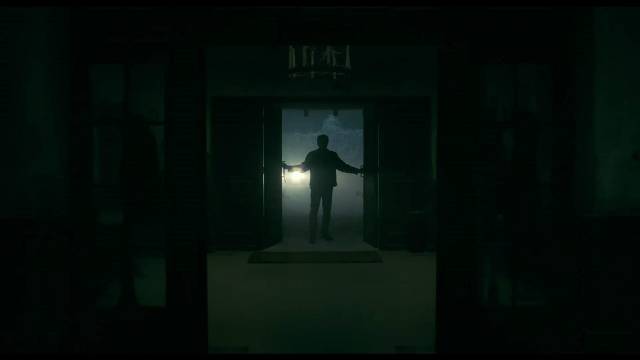
And then there’s Rebecca Ferguson, who invests Rose with such seductive charm that she seldom has to overtly express the evil that drives her; it’s been a while since I read the book, but I don’t remember Rose being this sexy and desirable. She makes a really formidable opponent for Dan as he struggles to regain the power he’s tried for decades to shed and for Abra as she wields the even greater power she’s just learning how to use.
Doctor Sleep is one of King’s best recent novels, and Flanagan has made of it one of the best King adaptations yet.
Comments